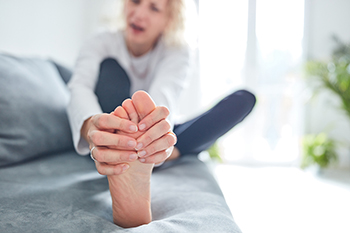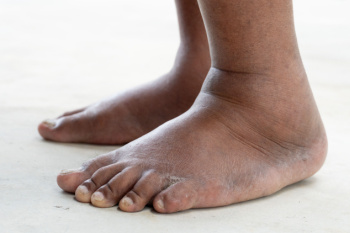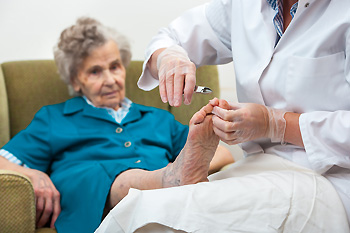NJ (908) 688-5577
NY (212) 737-2528

Foot pain can originate from various areas, each indicating different potential causes. Generalized toe pain may suggest conditions like arthritis or improper footwear causing pressure. Pain in the big toe often points to gout or bunions, while discomfort in the ball of the foot may be due to metatarsalgia from high-impact activities or wearing high heels. Heel pain, commonly associated with plantar fasciitis, occurs due to inflammation of the ligament connecting the heel bone to the toes. Arch pain may signal conditions, such as flat feet or plantar fasciitis, where the arch support structure is strained. Identifying the precise location of foot pain helps determine appropriate treatments, such as rest, stretching exercises, or orthotic inserts. If you have any type of foot pain, it is suggested that you consult a podiatrist who can provide an accurate diagnosis and a tailored treatment plan.
Foot Pain
Foot pain can be extremely painful and debilitating. If you have a foot pain, consult with Glenn Davison, DPM from Advanced Podiatry. Our doctor will assess your condition and provide you with quality foot and ankle treatment.
Causes
Foot pain is a very broad condition that could be caused by one or more ailments. The most common include:
Diagnosis
To figure out the cause of foot pain, podiatrists utilize several different methods. This can range from simple visual inspections and sensation tests to X-rays and MRI scans. Prior medical history, family medical history, and any recent physical traumatic events will all be taken into consideration for a proper diagnosis.
Treatment
Treatment depends upon the cause of the foot pain. Whether it is resting, staying off the foot, or having surgery; podiatrists have a number of treatment options available for foot pain.
If you have any questions, please feel free to contact our offices located in Union, NJ and New York . We offer the newest diagnostic and treatment technologies for all your foot care needs.
 Athlete's foot, also known as tinea pedis, is a fungal infection that primarily affects the spaces between the toes. Anyone exposed to the fungus can become infected, not just athletes. Dermatophytes, the fungi responsible for this condition, thrive in warm, moist environments, making hot, sweaty feet the perfect breeding ground. Symptoms can include redness, cracking, flaking, and itching of the skin, particularly between the toes. Athlete's foot is extremely contagious, spreading through direct contact or via contaminated surfaces like gym locker rooms and communal showers at indoor pools. Risk factors can include eczema, excessive sweating, weakened immune systems, circulation problems, and wearing sturdy, non-breathable footwear. A podiatrist can diagnose athlete’s foot and recommend effective treatments as well as provide preventive measures to keep the infection from recurring. If you have developed an athlete's foot infection, it is suggested that you schedule an appointment with a podiatrist for an exam, diagnosis, and treatment options.
Athlete's foot, also known as tinea pedis, is a fungal infection that primarily affects the spaces between the toes. Anyone exposed to the fungus can become infected, not just athletes. Dermatophytes, the fungi responsible for this condition, thrive in warm, moist environments, making hot, sweaty feet the perfect breeding ground. Symptoms can include redness, cracking, flaking, and itching of the skin, particularly between the toes. Athlete's foot is extremely contagious, spreading through direct contact or via contaminated surfaces like gym locker rooms and communal showers at indoor pools. Risk factors can include eczema, excessive sweating, weakened immune systems, circulation problems, and wearing sturdy, non-breathable footwear. A podiatrist can diagnose athlete’s foot and recommend effective treatments as well as provide preventive measures to keep the infection from recurring. If you have developed an athlete's foot infection, it is suggested that you schedule an appointment with a podiatrist for an exam, diagnosis, and treatment options.
Athlete’s foot is an inconvenient condition that can be easily reduced with the proper treatment. If you have any concerns about your feet and ankles, contact Glenn Davison, DPM from Advanced Podiatry. Our doctor will treat your foot and ankle needs.
Athlete’s Foot: The Sole Story
Athlete's foot, also known as tinea pedis, can be an extremely contagious foot infection. It is commonly contracted in public changing areas and bathrooms, dormitory style living quarters, around locker rooms and public swimming pools, or anywhere your feet often come into contact with other people.
Solutions to Combat Athlete’s Foot
Athlete’s foot can cause many irritating symptoms such as dry and flaking skin, itching, and redness. Some more severe symptoms can include bleeding and cracked skin, intense itching and burning, and even pain when walking. In the worst cases, Athlete’s foot can cause blistering as well. Speak to your podiatrist for a better understanding of the different causes of Athlete’s foot, as well as help in determining which treatment options are best for you.
If you have any questions please feel free to contact our offices located in Union, NJ and New York . We offer the newest diagnostic and treatment technologies for all your foot and ankle needs.
 Swelling of the feet, also known as edema, is a condition that results from an abnormal accumulation of fluid in the tissues of the feet and ankles. This swelling can be caused by various factors, including standing or sitting for long periods, pregnancy, or obesity. Injury, or underlying health conditions like heart disease or kidney problems are other risk factors. Swollen feet can be uncomfortable, may restrict mobility, and can make daily tasks difficult to complete. Often, simple changes in regimen, such as elevating the feet, wearing compression socks, staying hydrated, and engaging in regular exercise may reduce the amount of swelling in the feet. If swelling persists or is accompanied by other concerning symptoms, it is suggested to seek evaluation and treatment from a podiatrist to ensure proper management and prevent complications.
Swelling of the feet, also known as edema, is a condition that results from an abnormal accumulation of fluid in the tissues of the feet and ankles. This swelling can be caused by various factors, including standing or sitting for long periods, pregnancy, or obesity. Injury, or underlying health conditions like heart disease or kidney problems are other risk factors. Swollen feet can be uncomfortable, may restrict mobility, and can make daily tasks difficult to complete. Often, simple changes in regimen, such as elevating the feet, wearing compression socks, staying hydrated, and engaging in regular exercise may reduce the amount of swelling in the feet. If swelling persists or is accompanied by other concerning symptoms, it is suggested to seek evaluation and treatment from a podiatrist to ensure proper management and prevent complications.
Swollen feet can be a sign of an underlying condition. If you have any concerns, contact Glenn Davison, DPM of Advanced Podiatry. Our doctor can provide the care you need to keep you pain-free and on your feet.
Swollen feet are a common ailment among pregnant women and people who stand or sit for extended periods. Aging may increase the possibility of swollen feet and patients who are obese often notice when their feet are swelling too. There may be medical reasons why swollen feet occur:
Swollen feet can also be caused by bone and tendon conditions, including fractures, arthritis, and tendinitis. Additionally, there may be skin and toenail conditions and an infection may cause the feet to swell. Patients who take medicine to treat high blood pressure may be prone to getting swollen feet.
Many patients elevate their feet to help relieve the swelling and this is generally a temporary remedy. When a podiatrist is consulted the reason behind the swelling can be uncovered and subsequently treated.
If you have any questions please feel free to contact our offices located in Union, NJ and New York . We offer the newest diagnostic tools and technology to treat your foot and ankle needs.
 Foot exams are important for older adults, as aging often brings about various foot problems that can significantly impact mobility and increase the risk of falls. Over time, feet undergo changes such as loss of fat padding, reduced blood circulation, and structural alterations, making them more susceptible to conditions like arthritis, bunions, and plantar fasciitis. Additionally, common age-related issues like diabetes can lead to neuropathy and other complications that exacerbate foot problems. Regular foot care becomes more critical with age, as maintaining foot health directly contributes to overall well-being and independence. If self-care becomes challenging, it is essential to seek assistance from caregivers or healthcare professionals to ensure proper hygiene and monitoring. Routine foot exams involve checking for signs of skin breakdown, infections, deformities, and circulation issues. A podiatrist may also assess gait and balance to prevent falls. If you are a senior, it is suggested that you schedule an appointment with a podiatrist for comprehensive foot care, as they specialize in diagnosing and treating foot-related issues.
Foot exams are important for older adults, as aging often brings about various foot problems that can significantly impact mobility and increase the risk of falls. Over time, feet undergo changes such as loss of fat padding, reduced blood circulation, and structural alterations, making them more susceptible to conditions like arthritis, bunions, and plantar fasciitis. Additionally, common age-related issues like diabetes can lead to neuropathy and other complications that exacerbate foot problems. Regular foot care becomes more critical with age, as maintaining foot health directly contributes to overall well-being and independence. If self-care becomes challenging, it is essential to seek assistance from caregivers or healthcare professionals to ensure proper hygiene and monitoring. Routine foot exams involve checking for signs of skin breakdown, infections, deformities, and circulation issues. A podiatrist may also assess gait and balance to prevent falls. If you are a senior, it is suggested that you schedule an appointment with a podiatrist for comprehensive foot care, as they specialize in diagnosing and treating foot-related issues.
If you need your feet checked, contact Glenn Davison, DPM of Advanced Podiatry. Our doctor will attend to all of your foot and ankle needs and provide you with quality treatment.
Geriatrics and Podiatry
When people age, some common issues that may occur are bone density loss, dry skin, poor circulation, and rough brittle nails. These issues may also affect your foot health if the necessary steps are not taken to alleviate the problems.
It is important to take care of your feet because feet that are injured or diseased can affect your overall health. Having painful feet hinders your ability to do daily activities or may decrease your willingness to do the things that you need to do.
Visiting Your Geriatrician
As we age, health problems become more likely, so it is essential to visit your doctor for check-ups to ensure that you are doing the best you can to take care of your health. It is recommended to check your feet frequently for any possible cuts, bruises, swelling, corns or any other irregularities.
Taking Care of Elderly Feet
Cracked or dry feet can be treated by applying moisturizer often. It is also important not to wear old socks because the older the sock is, the higher the possibility there will be that there is bacteria there. Wear fresh socks and make sure they fit properly.
Proper foot health means that you can have a more active lifestyle and you will not be bogged down by pain. Foot health also leads to good circulation, which is paramount for overall health.
If you have any questions, please feel free to contact our offices located in Union, NJ and New York . We offer the newest diagnostic tools and technology to treat your foot and ankle needs.

Foot blisters are small, fluid-filled pockets that form on the upper layers of the skin, typically caused by friction. These blisters often develop due to repetitive rubbing against shoes or socks during activities such as walking, running, or hiking. When the skin experiences constant friction, the outer layer separates from the underlying layers, creating a space that fills with fluid. Moisture from sweat can exacerbate this process, making blisters more likely. Common areas for foot blisters include the heels, toes, and soles. While generally not serious, blisters can be painful and impact mobility. To prevent blisters, it is important to wear well-fitting shoes and moisture-wicking socks, and to keep feet dry. If a blister forms, it should be kept clean and protected to prevent infection and promote healing, and avoiding further irritation is vital for recovery. Foot blisters are often uncomfortable, and can hinder completing daily tasks. If you have a blister on your foot that has become infected, it is suggested that you visit a podiatrist who can offer relief and treatment techniques.
Blisters are prone to making everyday activities extremely uncomfortable. If your feet are hurting, contact Glenn Davison, DPM of Advanced Podiatry. Our doctor can provide the care you need to keep you pain-free and on your feet.
Foot Blisters
Foot blisters develop as a result of constantly wearing tight or ill-fitting footwear. This happens due to the constant rubbing from the shoe, which can often lead to pain.
What Are Foot Blisters?
A foot blister is a small fluid-filled pocket that forms on the upper-most layer of the skin. Blisters are filled with clear fluid and can lead to blood drainage or pus if the area becomes infected.
How Do Blisters Form?
Blisters on the feet are often the result of constant friction of skin and material, usually by shoe rubbing. Walking in sandals, boots, or shoes that don’t fit properly for long periods of time can result in a blister. Having consistent foot moisture and humidity can easily lead to blister formation.
Prevention & Treatment
It is important to properly care for the affected area in order to prevent infection and ease the pain. Do not lance the blister and use a Band-Aid to provide pain relief. Also, be sure to keep your feet dry and wear proper fitting shoes. If you see blood or pus in a blister, seek assistance from a podiatrist.
If you have any questions, please feel free to contact our offices located in Union, NJ and New York . We offer the newest diagnostic and treatment technologies for all your foot care needs.